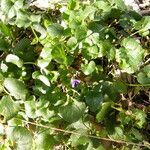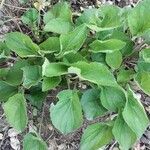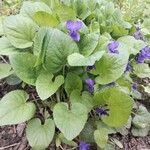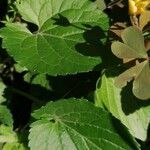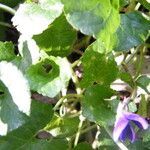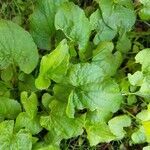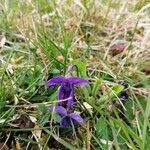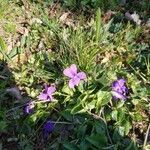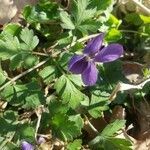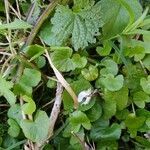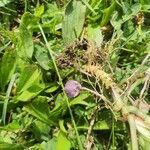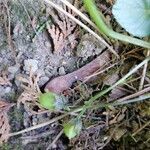Herb, acaulescent, stoloniferous. Leaves with the petioles up to 9 cm long, the stipules narrowly ovate, acuminate, up to 1.5 cm long, glandular-fimbrillate; blade subcircular, deeply cordate at the base, obtuse at the apex, crenulate at the margins, up to 5.2 cm long and wide, membranous, with scattered, appressed, hyaline, short hairs on both surfaces and along the margins. Flowers with the pedicels up to 9 cm long, the bracteoles narrowly triangular, acute, ca 6 mm long and 1.5 mm wide at the base, minutely glandular-fimbrillate; sepals ovate, acute, ca 10 mm long (basal auricles included) and 3-4 mm wide, the basal auricles ca 3 mm long and fimbrillate at the base; corolla purple; anterior petal oblong-obovate, rounded at the apex, 15 mm long (spur included) and 6 mm wide, the spur ca 4 mm long; lateral and upper petals oblong-obovate to obovate, rounded at the apex, 12 mm long and 5-7 mm wide; anthers ca 2 mm long, the connective appendages deltoid, ca 1.5 mm long and wide at the base; ovary ovoid, as long as the anthers; style ? geniculate at the base, enlarged towards the apex, ca 2.5 mm long, the apex unciform. Capsule ellipsoid, ca 7-8 mm long, puberulous.
Plants perennial, acaulescent, stoloniferous, 4–12 cm; stolons green, often rooting at nodes and forming leafy rosettes; rooted rosettes often develop into erect, rhizomatous caudex from which new stolons are produced; rhizome thick, fleshy. Leaves basal (and from stolons), 5–10, ascending to erect; stipules lanceolate to linear-lanceolate, margins fimbriate, projections gland-tipped, apex acute; petiole 2–17 cm, puberulent; blade unlobed, ovate to orbiculate, 1.5–7 × 1.5–5 cm, base cordate, margins crenate, ciliate, apex obtuse to rounded, surfaces puberulent. Peduncles 4–15 cm, puberulent. Flowers: sepals narrow to broadly lanceolate, margins ciliate, auricles 3–4 mm; petals deep to pale blue-violet, pale blue, or white on both surfaces, usually white basally, lateral 2 sparsely to densely bearded, lowest usually purple-veined, 12–22 mm, spur usually same color as petals, elongated, 5–7 mm; style head beardless; cleistogamous flowers on prostrate or ascending peduncles. Capsules sometimes purple-flecked, ovoid, 5–8 mm, puberulent. Seeds brown, 3–4 mm. 2n = 20.
Perennial; rhizome vertical, stout, bearing rosette of leaves and usually long, procumbent rooting stems at apex. Leaves 2½-6 by 2½ by 6½ cm, orbicular-reniform to-ovate, deeply cordate, rounded to obtuse, shallowly crenate to crenate-serrate, glabrous or sparsely pubescent on veins and margins; petiole up to 20 cm. Stipules 8-12 by 3-5 mm, ovate to ovate-lanceolate, usually glandular-fimbriate, glabrous, free. Flowers 10-15 mm, purple or white; peduncles 5-14 cm, slender. Sepals c. 5 by c. 2 mm, ovate, obtuse, entire, with ciliate margins; appendage 1-2 mm, dentate. Petals broadly obovate, laterals bearded or not; spur c. 4 mm, straight or slightly upcurved. Style c. 2 mm, uncinate at apex. Capsule globose, pubescent.
Rhizomatous perennial; aerial stems 0. Lvs all rosulate, with fine hairs above and beneath, (2)-4-8 × (2)-3-7 cm, broadly ovate-cordate, obtuse to subacute, with > 15 crenations each side; stipules linear to lanceolate, dentate, 1-2 cm long; petiole (3)-5-10-(20) cm long, with deflexed hairs. Peduncles erect, glabrous or hairy; bracts linear-acuminate, dentate, 5-10 mm long. Fls 1.5-2.5 mm diam. Sepals narrowly oblong, subacute to obtuse, 4-6 mm long; appendages 1-2 mm long. Petals violet or white or pink, exceeding sepals, the lateral bearded; spur 3-5 mm long, > sepal appendages. Style not geniculate at base, 2.5 mm long; stigma beaked. Capsule globose, hairy, c. 1 cm long. Seeds obovoid, pale brown, 2.5 mm long.
Perennial herb with short, erect stems and slender stolons/rhizomes, sparsely pubescent. Leaves cauline and in rosettes; lamina ovate-orbicular to broadly ovate, 15–70 (–105) mm long, 15–70 (–85) wide, apex obtuse, margins crenulate, base deeply cordate; petiole to 25 cm long, pubescent with deflexed hairs; stipules ovate-lanceolate, glandular, ciliate to laciniate, 10–13 mm long, free. Flower-scapes 6–12 cm long; bracteoles near middle; flowers fragrant. Sepals elliptic or ovate, obtuse, 5–6 mm long. Petals 12–17 mm long, violet, white or rarely magenta, the anterior prominently spurred at base. Capsule ellipsoid, 7–9 mm long, pubescent.
Finely hairy, with a long-creeping rhizome and spreading by numerous leafy stolons rooting at the nodes; lvs broadly ovate to orbicular, 2–6 cm, rounded or obtuse at the tip, evenly crenate, cordate at base, peduncles equaling or shorter than the lvs; fls very fragrant, typically deep violet, varying to white, the lateral pet usually bearded; style recurved-hooked at the tip; sep ciliate; ovary and fr hairy; cleistogamous fls on recurving peduncles, with broadly ovoid, hairy, purplish fr; seeds large, ochroleucous; 2n=20. Native of Europe, cult. in many forms and often escaped, especially about dwellings. Apr., May.
Finely hairy, with a long-creeping rhizome and spreading by numerous leafy stolons rooting at the nodes; lvs broadly ovate to orbicular, 2–6 cm, rounded or obtuse at the tip, evenly crenate, cordate at base, peduncles equaling or shorter than the lvs; fls very fragrant, typically deep violet, varying to white, the lateral pet usually bearded; style recurved-hooked at the tip; sep ciliate; ovary and fr hairy; cleistogamous fls on recurving peduncles, with broadly ovoid, hairy, purplish fr; seeds large, ochroleucous; 2n=20. Native of Europe, cult. in many forms and often escaped, especially about dwellings. Apr., May.
A herb. It keeps growing from year to year. It grows 10-15 cm high and spreads 30-60 cm wide. It has rooted runners. The leaves are heart shaped. They cluster around the base of the plant. The flowers are violet blue. They have a sweet smell. The fruit are round, hairy capsules.
